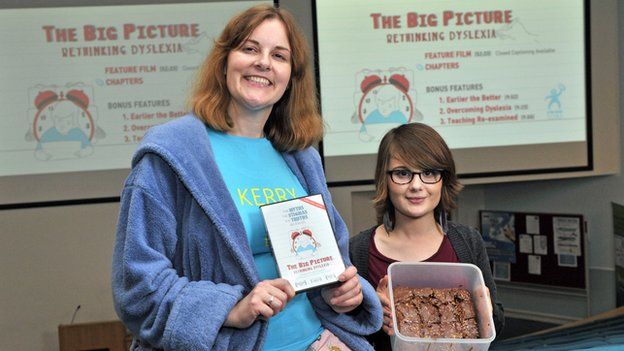Mother and daughter with dyspraxia offer help on video
- Published

A mother and daughter with dyspraxia have been making friendly, informal videos to help those who share their condition.
Kerry Pace loves gardening and dancing. She runs a company that helps disabled students who find regular learning methods difficult, mentoring them over Skype on time management and organisation.
Kerry's daughter, 17-year-old Phoebe Pace, loves baking, craft and her Staffordshire bull terrier. She's currently studying for her A-levels and recently started a blog about how she tackled overwhelming anxiety.
They both have dyspraxia, a common disorder which affects motor co-ordination. It can make activities such as writing or riding a bike difficult, and can cause problems with language, perception and thought.
In their spare time the mother and daughter from Hornsea in East Yorkshire make chatty video blogs full of helpful ideas for others with dyspraxia - from sleep advice to tips on how to use a toothbrush, all based on their personal and professional experience.
In your videos you often talk about eating. Is it a typical dyspraxia problem?
Phoebe: I used to struggle getting everything on to my fork so it didn't fall off on the way to my mouth. One day, however, when there was no proper cutlery around, I resorted to using the child-sized forks left in the drawer. I found them so much easier to manage because they are lighter and have bigger handles. I love sporks - they're the perfect mixture between a spoon and a fork and are deep enough to balance food on. After watching our video, loads of people tried it and said "Wow, I wish I'd known that earlier."
And why did you make a video about sleep?
Kerry: Sleep can be a real problem. Like many with dyspraxia, I have a sensory processing disorder. So, if you know that you can't sleep but can't quite pin down the reason why, take time to evaluate what your senses are feeding you. Is the room temperature right? Is it dark enough, or light enough? Do you want music on or off? What are you wearing - is it tight around your wrists? Does it have an itchy label? I like flanellete bedsheets because they are warm when I get in, but Phoebe prefers cold cotton ones. I have a hot blanket that has a setting which lets you regulate feet and body separately, good for me because my feet are always cold.
You connect dyspraxia with anxiety in your videos. Why?
Kerry: On one of Phoebe's blogs, Dyspraxia UK commented that of all the associated secondary difficulties people can get with the disorder, anxiety is high on the list. That's because we use so much energy just to do everyday things. Coordination is the main symptom of dyspraxia, everyone knows about that, but many start to believe they have a mental health problem because they panic and can't function on an escalator, for instance. Escalators are known to be particularly difficult to use successfully because you need to process multiple things at once, like the fact you're going downwards, at an angle, or at speed. It takes longer to plan your movements to get off safely at the bottom. Occupational therapists tasked with assessing you for dyspraxia will often ask how you get on with escalators. In the video we talk a lot about self compassion. Be easy on yourself and be realistic in your goal setting. And take breaks, they're vital.
Follow @BBCOuch on Twitter and on Facebook, and listen to our monthly talk show